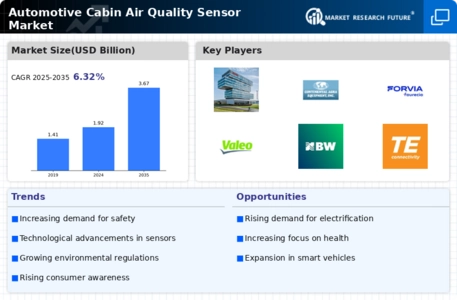Automotive Cabin Air Quality Sensor Market Summary
The Global Automotive Cabin Air Quality Sensor Market is projected to grow from 1.92 USD Billion in 2024 to 3.67 USD Billion by 2035.
Key Market Trends & Highlights
Automotive Cabin Air Quality Sensor Key Trends and Highlights
- The market is expected to achieve a compound annual growth rate (CAGR) of 6.06% from 2025 to 2035.
- By 2035, the market valuation is anticipated to reach 3.67 USD Billion, indicating robust growth potential.
- In 2024, the market is valued at 1.92 USD Billion, reflecting the increasing focus on air quality in vehicles.
- Growing adoption of advanced sensor technologies due to heightened consumer awareness of health and environmental issues is a major market driver.
Market Size & Forecast
| 2024 Market Size | 1.92 (USD Billion) |
| 2035 Market Size | 3.67 (USD Billion) |
| CAGR (2025-2035) | 6.06% |
Major Players
Robert Bosch, Honeywell International, Hella GmbH, Amphenol Corporation, Panasonic Corporation, Continental AG, DENSO Corporation, Faurecia, Valeo, BorgWarner, TE Connectivity, Mitsubishi Electric, Murata Manufacturing, Delphi Technologies, Sensata Technologies











